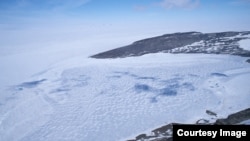Life on Earth can be found in some of the least likely places, and now British researchers say they’ve found “evidence of diverse life forms dating back nearly 100,000 years” in a subglacial lake in Antarctica.
"What was surprising was the high biomass and diversity we found,” said the paper’s lead author, David Pearce of the University of North Umbria, who worked on the project with his colleagues and scientists from the British Antarctic Survey. “This is the first time microbes have been identified living in the sediments of a subglacial Antarctic lake and indicates that life can exist and potentially thrive in environments we would consider too extreme."
He added that since the organisms survived in such an environment, it “could mean they have developed in unique ways which could lead to exciting discoveries for us."
Some of the life discovered was in the form of fossil DNA showing that many different types of bacteria lived there, including a range of extremophiles, which are species adapted to the most extreme environments. These are thought to use a mix of chemicals to sustain life, some with oxygen and some without.
One DNA sequence was related to the most ancient organisms known on Earth, the researchers said, and parts of the DNA in 23 percent of the specimens have not been previously described.
Scientists believe organisms living in subglacial lakes could hold clues for how life might develop on other planets.
Scientists have been searching around the retreating margins of the ice sheet for subglacial lakes that are becoming exposed for the first time since they were buried more than 100,000 years ago.
The group targeted Lake Hodgson on the Antarctic Peninsula, which was covered by more than 400 meters of ice at the end of the last Ice Age. It is now considered to be an emerging subglacial lake with a thin covering of just three to four meters of ice.
"What was surprising was the high biomass and diversity we found,” said the paper’s lead author, David Pearce of the University of North Umbria, who worked on the project with his colleagues and scientists from the British Antarctic Survey. “This is the first time microbes have been identified living in the sediments of a subglacial Antarctic lake and indicates that life can exist and potentially thrive in environments we would consider too extreme."
He added that since the organisms survived in such an environment, it “could mean they have developed in unique ways which could lead to exciting discoveries for us."
Some of the life discovered was in the form of fossil DNA showing that many different types of bacteria lived there, including a range of extremophiles, which are species adapted to the most extreme environments. These are thought to use a mix of chemicals to sustain life, some with oxygen and some without.
One DNA sequence was related to the most ancient organisms known on Earth, the researchers said, and parts of the DNA in 23 percent of the specimens have not been previously described.
Scientists believe organisms living in subglacial lakes could hold clues for how life might develop on other planets.
Scientists have been searching around the retreating margins of the ice sheet for subglacial lakes that are becoming exposed for the first time since they were buried more than 100,000 years ago.
The group targeted Lake Hodgson on the Antarctic Peninsula, which was covered by more than 400 meters of ice at the end of the last Ice Age. It is now considered to be an emerging subglacial lake with a thin covering of just three to four meters of ice.












